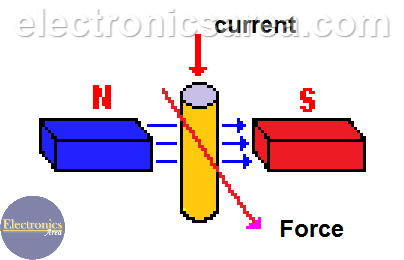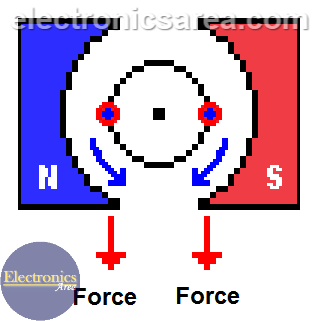DC Motor – Basic Operation Principle – DC Motor Counter-electromotive force – Load effect
DC Motor
Parts of a DC Motor
A DC motor is composed of a stator and a rotor. In many small DC motors, the stator is composed of magnets that are used to create a magnetic field. In larger DC motors this magnetic field is obtained with field excitation winding.
The rotor rotates in the center of the DC motor and is composed of conductor cable windings. The direct current is supplied to the rotor of the motor by means of “brushes” generally made of carbon.
Note: Winding are composed of conducting wires that have a specific purpose within an engine.
Basic DC Motor Operation Principle
When a conductor through which a direct current flows is placed under the influence of a magnetic field, a force is induced on it (the conductor) which is perpendicular both to the magnetic field lines and to the direction of the flow of the current. See the following image.
- Magnetic field arrows in blue
- Direct current arrow in red
- Force arrow in red
- Magnets: N (north) and S (south)
To better understand how this conductor is placed with respect to the rotor axis rotation and to understand why is there a rotation movement.
In this case the current through the conductor flows entering the image.
- Torque in blue
- Force in red
- Conductor cable in blue and red
- Magnets: N (north) and S (south)
In the rotor of a DC motor there is not only one conductor cable but many. If another conductor is included exactly on the other side of the rotor and with the current flowing in the same direction, the motor will not turn because the two forces exerted for the motor rotation are canceled. See this case in the following diagram.
- Torque arrows in blue
- Forces in red
- Current in blue and red
- Magnets: N (north) and S (south)
This is the reason why currents flowing through opposite conductors must have opposite directions. If this is done, the motor will rotate by the sum of the force exerted on the two conductors. To control the flow direction of the current in the conductors, a switch is used that reverses the direction of the current when the conductor passes through the deadline of the magnetic field.
The force with which the motor rotates (the motor torque) is proportional to the current flowing through the conductors. The higher the voltage, the more current there will be and the higher the torque.







